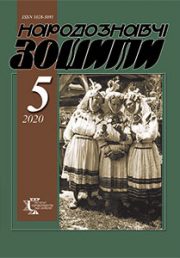The Ethnology Notebooks. 2018, 2 (140), 463—468.
UDK 738.031.4:378.091.31(477.86-21)
DOI https://doi.org/10.15407/nz2018.02.463
Received 20.02.2018
ORCID ID: https://orsid.org/0000-0001-6936-0328
Motyl Romana Yaroslavivna, Candidate in Arts (Ph.D.), Senior Researcher at the Institute of Ethnology
of the National Academy of Sciences of Ukraine,
department of Folk Art, Associate Professor
of the Department of Design and Architecture Fundamentals
at the Institute of Architecture of Lviv Polytechnic National University.
Svobody Avenue 15, 79000, Lviv, Ukraine.
Contacts: Tel. (067)6708698; e-mail: romana_motyl@ukr.net
Abstrakt. The article spotlights the role of folk traditions in the process of transferring professional pottery knowledge at the department of artistic ceramics of the Kosiv State Institute of Applied and Decorative Arts named after Vasyl Kasiyan of the Lviv National Academy of Arts. The conditions and circumstances under which the form of teaching takes place are analyzed, and some regional features of this process are indicated.
Keywords: folk traditions, artistic ceramics, pottery, education, Kosiv State Institute of Applied and Decorative Arts named after Vasyl Kasiyan of the Lviv National Academy of Arts.
REFERENCES
Ivanchuk, M.M. (2002). Vykorystannia tvorchykh zdobutkiv Mykhajla Kikotia v navchal’nomu protsesi. Mystets’ki studii’02. (pp. 55—59). Kosiv: Pysanyj kamin’ [in Ukrainian].
Kolos, H.M. (2002). Pytannia styl’ovoho spriamuvannia navchal’noho protsesu na viddili khudozhn’oi keramiky Kosivs’koho koledzhu im. V.I. Kasiiana. Mystets’ki studii’02. (pp. 51—54). Kosiv: Pysanyj kamin’ [in Ukrainian].
Kosivs’kyj koledzh prykladnoho ta dekoratyvnoho mystetstva. Keramika 40. Kataloh (1999). Kosiv: KKPDM im. V.I. Kasiiana [in Ukrainian].
Kushnir, O. Rol’ viddilu khudozhn’oi keramiky Kosivs’koho instytutu prykladnoho ta dekoratyvnoho mystetstva u zberezhenni j rozvytku tradytsij vyhotovlennia ta dekoruvannia narodnoi keramiky Hutsul’schyny. Visnyk L’vivs’koi natsional’noi akademii mystetstv. (Vyp. 30, pp. 62—71) [in Ukrainian].
Laschuk, Yu.F. (1982). Vopros podhotovky kadrov dlia narodnykh khudozhestvennykh promyslov Problemy narodnoho yskusstva: sb. statej. (pp. 113—123). Moskva: Yzobrazytel’noe yskusstvo [in Russian].
Laschuk, Yu. (1968). Ukrains’ki honchari. Kyiv: Naukova dumka [in Ukrainian].
Sakovych, I.V. (1975). Narodni khudozhni tradytsii v ukrains’kij narodnij promyslovosti. Kyiv: Naukova dumka [in Ukrainian].
Slobodian, O. (2007). Majstry kosivs’koho honcharstva druhoi polovyny XX stolittia. Visnyk L’vivs’koi natsional’noi akademii mystetstv. (Spetsvypusk III. pp. 117—128). L’viv [in Ukrainian].
Solomchenko, O.H. (1979). Suchasni khudozhni promysly Prykarpattia. — Kyiv: Znannia [in Ukrainian].
Susak, K.R. (2002)/ Kosivs’ke uchylysche prykladnoho ta dekoratyvnoho mystetstva: stanovlennia fakhovoi shkoly ta perspektyvy rozvytku. Mystets’ki studii’02. (pp. 4—9). Kosiv: Pysanyj kamin’ [in Ukrainian].






